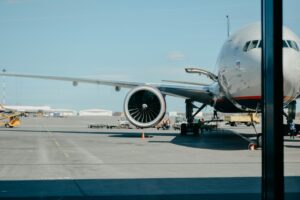CO2 and non-CO2 emissions caused by flying aren’t simply lost in the clouds. There are actions policymakers and airlines can take today to alleviate aviation’s climate impact, explains CMW’s Bastien Bonnet-Cantalloube
Summer has arrived, and it is time for that well earned holiday. However, when fretting over the last-minute stuffing of the suitcase or the eternal question of ‘where did I leave my passport?’, another, more serious question might have entered your mind: ‘What is the climate impact of my summer flight?’
Many holidaymakers will opt to fly this summer. In the EU alone, last year there were 6.3 million commercial flights, with a third of these taking place during the peak June, July and August season. This year’s total is forecast to be even higher – a 5-7% increase on traffic levels, as the industry celebrates “taking millions of customers away on their holidays”.
Knowing the full climate impact of aviation gives a feeling of discomfort normally reserved only for the middle seat during turbulence on a long haul voyage, though.
In carrying suitcases and travellers across the sky, an aeroplane spews out significant amounts of CO2 emissions together with non-CO2 gases and particles that at least double the warming effect of CO2 alone. But, what are these non-CO2 effects and what are airlines telling us about them?
Soaring emissions
Flying devastates the climate like no other travel form, generating the highest impact per passenger kilometre. Although airlines have made increasingly efficient use of jet fuel over the years, the rise in passenger traffic has more than outdone these savings. This year, a record number of air travellers is expected.
Unsurprisingly, air travel emissions continue to climb, increasing by 10% in the EU in 2023 compared to 2022, showing a significant diversion from the sector’s stated 2050 net zero emissions target.
Cloud damage
For aviation, CO2 emissions are only one part of the story. Aeroplanes also harm the climate through other emissions like water vapour, nitrogen oxides (NOx), sulphur dioxide (SO2), and soot particles.
These emissions lead to atmospheric processes such as ozone formation and contrails – the white streaks you see in the sky. When planes fly at high altitudes in cold, humid areas, the water vapour they emit condenses onto soot particles from the engines, forming water droplets. These droplets freeze into ice crystals, creating contrails. If the atmosphere remains cold and humid, contrails can spread and become absorbed into larger cirrus clouds.
If it were just for the visual effect, there wouldn’t be much cause for concern. However, contrail cirrus clouds trap heat from the Earth’s surface intensifying the warming effect, which is worst at night when no sunlight is reflecting back.
The climate damage alone from contrail cirrus is similar to that of aviation’s CO2 emissions. About 14% of flights create warming contrails, and only 2% of flights are causing 80% of the warming effect, typically long-haul flights such as transatlantic voyages. But when considering the full package of non-CO2 aviation emissions the effect on the climate can be two to four times greater than the impact of CO2 emissions alone from air traffic, according to the IPCC and substantiated by more recent research (1; 2; 3; 4).
Mitigation ready for takeoff
The importance of mitigating the consequences of long-distance travel cannot be overstated. Unfortunately, the EU carbon market (the EU ETS) in its current form covers only CO2 and routes within Europe, and does nothing to tackle the other issues.
The good news is that the non-CO2 effects of all flights departing and landing in the EU will be monitored under the EU ETS starting in 2025. The real climate impacts of aviation have been known for 25 years, and this is an overdue but welcome departure.
That being said, the aviation industry is not keen on this taking off and has been lobbying against the monitoring of non-CO2 effects. International partners are pressing to minimise any ‘burden’ on their airlines. While the European Commission stands by introducing this monitoring, reporting and verification (MRV) system as of 2025 for flights within Europe, it proposed to delay its introduction by two additional years for routes that fly beyond EU airspace. This is a counterproductive decision because these effects are the largest on these longer voyages.
On the right (con)trail
So what can airlines do to lower their climate impact?
Rapidly increasing the use of (truly) sustainable and zero-carbon aviation fuels and renewable hydrogen is essential to lowering the destructive CO2 and non-CO2 ecological footprint of aviation. But we must not wait for the uptake of clean fuels, which is a longer term process, and must find other alternatives now.
For example, if flight paths were rerouted to areas and times of day when contrails do not form, much of the non-CO2 impact could be mitigated.
Moreover, reducing the number of flights in the sky is crucial to addressing the causes of CO2 and non-CO2 emissions, and would be key to diminishing health repercussions related to noise and ultra-fine particle pollution.
An increasing number of people realise they don’t need to fly to enjoy their holiday and are opting for low-carbon alternatives such as the train (through initiatives such as Mollow or Hourrail). There are many travel options out there that are fun and don’t cost the Earth!






